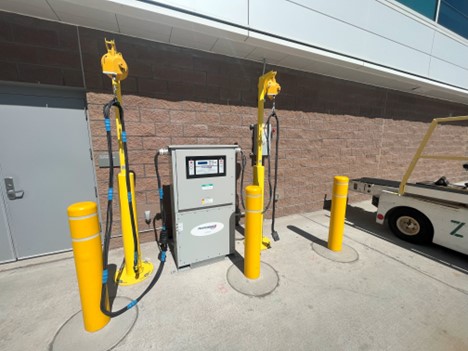
Written By Tim Castaldy
Electric vehicles (EVs) have been making significant inroads in various sectors, and one area where their potential is increasingly evident is airside operations at airports, where the benefits of using such vehicles are becoming increasingly clear. This article will examine the impact of electric vehicles on airport ground transportation, the benefits they offer, and the challenges they face.
Airport activities that fall under the category of “airside operations” include maintenance, passenger transportation, luggage handling, and aircraft movement. These operations have typically depended significantly on internal combustion engine powered vehicles. The aviation sector is, however, becoming more aware of the need to lessen its carbon footprint and make the switch to more sustainable methods. Electric vehicles are an essential tool in achieving this goal.
On airport tarmacs, electric ground support vehicles are increasingly widespread. These vehicles include electric tugs, baggage carts, and passenger shuttles. They offer several key advantages over their fossil-fuel counterparts:
- Environmental Benefits: The most prominent advantage of electric vehicles is their reduced carbon emissions. Airports are often located near densely populated areas, and the air quality around them can be compromised due to conventional vehicles. Electric vehicles produce zero tailpipe emissions, contributing to cleaner air quality.
- Healthier Working Environments: The air quality at airports is not great. Many workers who are exposed to the emissions during airside activities can face health issues due to this exposure. While most of these emissions come from the aircraft themselves, the more internal combustion engine powered vehicles that operate in and around airports, the greater the risk to workers.
- Cost Savings: While the upfront cost of electric ground support vehicles may be higher, they typically have lower operating and maintenance costs. Electricity is cheaper than gasoline or diesel fuel, and electric vehicles have fewer moving parts, leading to reduced maintenance expenses over time.
- Noise Reduction: Airports can be noisy environments, and electric vehicles are quieter than their internal combustion engine powered counterparts. This reduction in noise pollution benefits airport employees and nearby residents.
- Efficiency: Electric motors offer high torque at low speeds, making electric ground support vehicles suitable for towing aircraft and handling heavy loads efficiently. This can lead to improved operational productivity.
- Regulatory Compliance: Many countries and regions are introducing stricter emissions regulations, incentivizing airports to transition to electric ground support vehicles to comply with these requirements.
- Brand Image: Airports that invest in sustainable practices, including electric ground support vehicles, can enhance their brand image and appeal to environmentally conscious travelers.
Despite these advantages, there are challenges associated with the adoption of electric vehicles in airside operations:
- Infrastructure: Installing charging infrastructure at airports can be a significant undertaking. Airports need to invest in charging stations strategically placed throughout the airside area to ensure electric ground support vehicles can operate efficiently. The costs associated with the engineering and construction of this infrastructure is not an investment all airports are prepared to make.
- Range Limitations: While electric vehicles are suitable for short to medium-range tasks on the airside, long-haul applications such as runway inspection vehicles may require larger batteries or alternative solutions. While battery technology has come a long way, electric vehicles may not yet be the most effective way to accomplish many of these operations.
- Initial Costs: The upfront cost of electric ground support vehicles can be higher than their internal combustion engine powered counterparts, which may pose financial challenges for airports with limited budgets.
- Charging Time: Charging electric vehicles takes time, which can affect operational schedules if not managed efficiently. The difference in time that it takes to fully charge an electric vehicle is still significantly longer than it takes to fill up a tank of gas. With solid state battery technology on the horizon, charge times are expected to decrease significantly, and vehicle range is expected to increase significantly, however, this technology is still a few years out.
- Battery Degradation: Electric vehicle batteries degrade over time, and airport operators need to plan for battery replacement and disposal, which can have environmental implications.
- Battery Safety: Lithium-ion batteries are still the most effective battery technology for use in electric vehicles, however, these batteries can cause safety concerns if not safely used and maintained. Numerous instances of batteries combusting due to thermal runaway have occurred, causing injuries to persons, and damage to expensive equipment. These batteries contain hazardous chemicals that, if ignited, can be extremely difficult to extinguish.
- Limitation of Electrical Systems: The electrical systems that exist at most, if not all, airports today were not designed with electric vehicles in mind. The addition of electric ground support vehicles has put significant strain on these existing systems, to the point that many are in need of capacity upgrades to keep up with the demand. Electrification of all things airport related may be the future, but that future will not be possible if these systems are not upsized to meet that future demand.
At Denver International Airport in Colorado, PK Electrical Inc. has been working with United Airlines over the past few years to electrify their airside operations. From building a new parking lot with power pedestals to charge their electrified deicing fleet, to adding charging stations at every gate to power their ever-growing electric ground support vehicle fleet, United Airlines is leading the aviation industry’s charge (pun intended) toward an all-electric future. As an industry leader, United Airlines is setting the bar high and doing their part to better the world and the image of the aviation industry.
Due to their advantages for the environment, reduced costs, and increased efficiency, electric ground support vehicles are steadily making headway in airside activities at airports around the globe. For widespread implementation, however, issues with infrastructure, up-front expenses, battery technology, and overall safety must be resolved. Electric ground support vehicles are positioned to play a big part in the future of airside operations as airports work to minimize their carbon footprint and achieve sustainability goals. The future looks bright.








